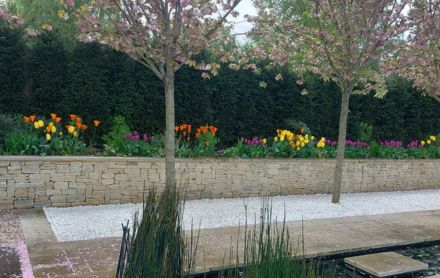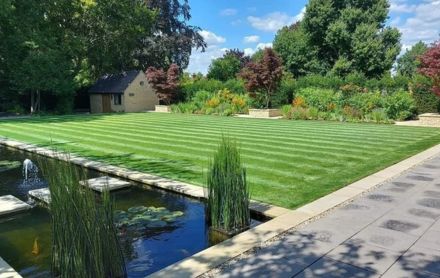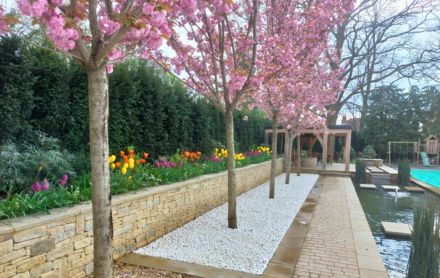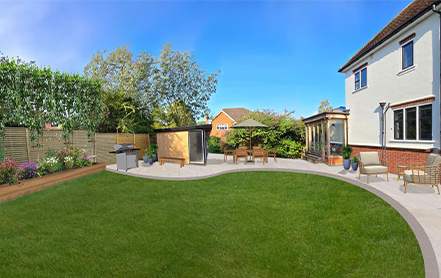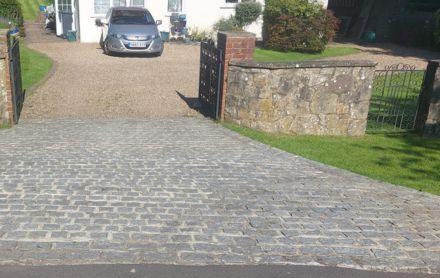Landscaping Strategies For Odd-Shaped Gardens
Creating the perfect outdoor space can be a complex process at the best of times, but this is made even more so when dealing with odd-shaped gardens. While no two gardens are exactly alike, some are easier to manage than others and you may be feeling at a loss for what to do.
Odd-shaped gardens can refer to any landscape that is slightly different from the norm. Whether your landscape has sharp corners, uneven surfacing, or an angular shape you may be struggling to make the most out of the area.
At Beautiful Spaces, we believe that every garden deserves to shine and see each landscape as a unique opportunity to create something beautiful. Using our experience as professional garden designers, we are sharing some of the best landscaping strategies you can implement to make the most out of odd-shaped gardens.
1) Vertical Planting
Vertical planting is one of the best solutions for odd-shaped gardens and those limited in space. This is a way to add colour, greenery or texture to the garden without compromising vital floor space as you make use of existing structures instead.
Rather than planting flowers or shrubs in the ground, you can train vines and climbing flora to grow against fences, walls or other garden structures like trellises or pergolas. This can create a pretty unique and attractive focal point for the garden, drawing the eyes away from the small or narrow floor space and beyond.
2) Use Hardy Plants
Odd-shaped gardens can make it difficult to get a uniform appearance of plants and flowers, due to the changing conditions each section may bring. However, this does not mean that you need to have an eclectic garden as there are other options out there.
Choosing succulents or even evergreen plants can be a great way to maintain a uniform appearance without worrying about the plants’ health based on their location. This is also a great tool to ensure your garden is low maintenance, without compromising on visual appeal, as many of these plants do not need as much pruning or watering to support their growth.
3) Mix Height And Texture
Even if you are limited in space due to your odd-shaped garden, you can still create stunning displays using flowers and plants.
A great way to create interest and make a beautiful display is by mixing different heights and textures of plants in one area. Whether this is a plot of land or even a container, adding multiple forms of ornamental grasses, shrubs and flowers can create interest.
You can opt for different species or plants within the same family, such as different kinds of grasses, to create a unique display that allows you to have colour and texture without taking away from the usable garden area you have left.
4) Be Strict With Decor
While you may be tempted to distract from your odd-shaped garden by incorporating as many plants, structures and decorative items as possible in the garden, this will only have the opposite effect.
The maxim ‘quality over quantity’ comes into play in many areas of landscaping, particularly when designing odd-shaped gardens as you do not want to clutter the space. Having too much going on is only going to highlight the odd shape of your garden and make it look less inviting than you intended.
5) Direct Interest With Hardscaping
Hardscaping elements, such as pathways and paving stones, can be a great way to keep interest in the best areas of your garden and ensure the odd areas are not included.
With pathways, you can direct guests to the key areas of your garden design and keep them away from the areas which cause you the most issues. Patios and decking can be used to create specific zones, allowing you to maximise the garden no matter the shape.
You can create separate zones to ensure hat you have room for everything you desire whether that is entertaining guests, the kid’s toys or even just a quiet space to relax outdoors with a cup of tea.
Common Challenges Of Odd-Shaped Gardens
When designing your odd-shaped garden, you may be faced with specific challenges that hinder your efforts and make you feel limited with your options to renovate.
However, as we have worked with all kinds of clients over the years, Beautiful Spaces has experience overcoming many challenges and has created some great strategies for specific issues you may face when dealing with odd-shaped gardens, including:
Narrow Spaces
One of the most common issues we face when dealing with odd-shaped gardens is the narrow spaces. Narrow spaces are often hard to control and may have limited design potential to an untrained eye, which is why your garden is not as great as it could be.
If you are dealing with small, narrow spaces that you do not know what to do with, there are several clever tricks that you can implement in your garden design to maximise potential. These include:
- Mirrors and reflective surfaces give the illusion of more space, as they catch the light
- Foldable and movable furniture is a great option to help save space, without compromising on outdoor dining or entertaining when you desire
- Choosing quality over quantity can ensure you get the best in design, without cluttering the space and making it seem even more narrow
Small spaces do not have to mean small design potential – as long as you are willing to be creative and flexible.
Multiple Microclimates
Having a garden with various areas of shade and light can create microclimates, which can make it difficult to choose plants for the whole space.
Each microclimate will have its own requirements of light, water, and soil due to the changing conditions so it is unlikely for you to have a uniform planting scheme across the whole garden. However, plants can still be used to add colour, scent and texture to odd-shaped gardens if you plan strategically:
- Evergreen shrubs and perennials can be used to add colour and texture to wide areas of the garden, even over microclimates, as these are designed to survive all seasons
- Understand the requirements of each microclimate and use this to inform your planting decisions – for example, how much light does the area get and what plants will thrive under these conditions
- Instead of thinking of your garden as an entire space, break it up into sections and use microclimates to create different zones or themes of design based on the conditions
Our passionate and knowledgeable team can offer a site assessment to determine what microclimates are present across your garden, as well as recommend the best plants for each area to ensure you always have access to colour, scent and texture.
Uneven Terrains
It is common for odd-shaped gardens to have uneven terrains and even sloping surfaces, which can make landscaping difficult. Much like with microclimates, the shape and slope of the terrain in each area can impact what will thrive in your garden and therefore the design options available to you.
However, as with the other challenges of odd-shaped gardens, it is possible to design a stunning space even with an uneven terrain:
- Creating a container garden, such as with raised flower beds and plant pots, can be used to add colour and texture to uneven areas. This allows you to have colour in the garden without worrying about the sloping soil, as each plant will be secured and contained in its own area
- Creating terraces using paving allows you to flatten the uneven terrain and have a dedicated space for entertaining or relaxing. There are many paving or decking options available that can be used to create a terrace in your garden, covering the uneven terrain
- Retaining walls can be installed at the base of the slope to add structure to the garden as well as limit soil erosion by halting the movement of the terrain
By implementing hardscaping like retaining walls and paving, you can make the most out of odd-shaped gardens and bypass the uneven terrain of the foundation.
Conclusion
While odd-shaped gardens can make landscaping more difficult, it does not have to completely ruin your dreams of a beautiful outdoor space. No matter the size, shape or layout of your garden it is possible to make the most out of your space and create an environment you love.
The garden designers and landscapers at Beautiful Spaces are highly experienced in their work, ensuring no need is too great for us. We have experience working with all kinds of gardens and can help those with even the most difficult space create something beautiful.


